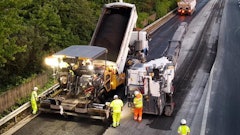
Find more information about these products and more at Volvo CE's World of Asphalt booth #1231.
DD25 Electric Compactor

Building on the success of Volvo’s electric compact excavators and wheel loaders, the company recently introduced the DD25 Electric asphalt compactor. The DD25 Electric brings zero-emissions equipment to the road and landscaping segments. This double-drum compactor offers 24 kW of available power, which is 30% more than its diesel equivalent. It’s ideal for jobsites with emission regulations or for organizations looking to meet their own sustainability goals. Zero tailpipe emissions also mean a cleaner, more enjoyable work environment for operators, site teams and passers-by. The DD25 Electric can operate for a full shift on a single charge, depending on the intensity of the work cycle. It comes with an integrated on-board charger that enables charging from zero to 100% in as little as three hours.
L180 3-Pass Rehandler

Volvo took their tried-and-true L180H wheel loader, swapped in larger tires and a long boom, added a rehandling counterweight, and created a new truck-loading dream machine called the L180 3-Pass Rehandler. Larger tires give the loader a wider footprint, providing extra floatation, durability and stability with an additional 675 lbf in breakout force and two more feet of dump clearance. The longer boom enables more efficient pile penetration, additional room between the loader and the truck, and better reach for dumping material into the center of the truck.
The machine’s configuration also decreases the risk of wheel spin and better protects the tires because operators can stay farther from the pile where the ground is less stable and rocks can damage the tires. The rehandling counterweight allows for a bucket that is approximately 0.25 yd³ larger than what a standard L180H can accommodate. Customers can choose between four different buckets to match the material density. Cycle times are improved by the higher reach because the operator won’t have to roll the bucket back to move away from the truck. Better cycle times mean better fuel efficiency, and a smaller class size saves buyers on the purchase price as well.


























